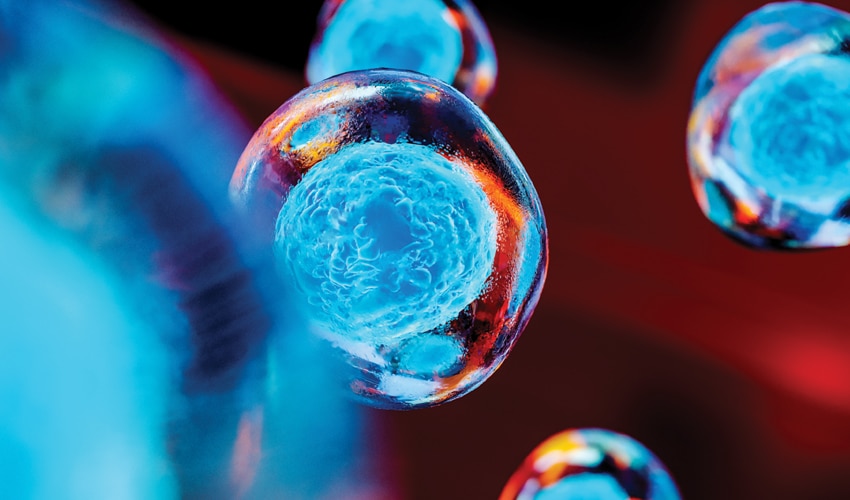Let’s continue our discussion of ortho biologics. The last article focused on the background and an in-depth look at platelet rich plasma (PRP). We will now focus on adipose derived cells (ADSC), bone marrow aspirate concentrate (BMAC), Wharton’s jelly (umbilical cord tissue), and amniotic fluid. All these interventions have gained popularity and are widely discussed among the public.
Current stem cell therapies are not true ‘stem cells,’ instead they are progenitor cells, which are early descendants of stem cells that can differentiate to form one or more kinds of cells. A progenitor cell is often more limited than a stem cell in the kinds of cells it can become. The two places we currently harvest these cells are from bone marrow and adipose tissue (fat).
Bone marrow, the spongy tissue within our bones, is a major producer of blood cells, which plays a very important role in the human body. Bone marrow is aspirated from the pelvis at the posterior superior iliac crest or anterior superior iliac crest. This procedure is done in the office under local anesthetic. Bone marrow aspirate is then run through a centrifuge for concentration as <1% are likely progenitor cells. This process is where we get the term ‘bone marrow aspirate concentrate’. Most research thus far has focused on osteoarthritis of the knee but use exceeds this indication to many musculoskeletal conditions and injuries. The properties of bone have been used for decades in orthopedics. This includes bone grafting to augment surgical procedures and help with bone healing. Additionally, micro-fracture, punching small holes into bone, to stimulate healing.
Adipose tissue has gained popularity due to its larger concentration of progenitor cells >20%. There is less variation with aging when compared to bone marrow. These progenitor cells are found in the form of pericytes, which live around the blood vessels. Adipose is harvested from the abdomen, thighs, or buttocks in the office under local anesthetic. Because of the high concentration of cells, adipose tissue does not need to be expanded or run through a centrifuge. The perivascular cells found in adipose exist as the body’s emergency repair cells that function during response to injury or demand for tissue healing. These cells can activate the healing pathways and may influence existing cells. Pre-clinical evidence is showing evidence of tendon healing, muscle healing, and inflammatory mediation. Suggested uses include early osteoarthritis, lateral epicondylitis, and rotator cuff repair. Fat grafting or fat injections have been used regularly in plastic surgery since the 90’s with early reports as far back as the late 19th century.
These two cellular therapies have a higher level of bio-activity than other biologics leading to a strong anti-inflammatory immune modulated response. This may lead to higher levels of pain relief. The science is complicated, but they contain higher concentrations of growth factors. There are many stem cell clinics making claims of regrowing tissue including cartilage. There are some small powered studies showing some regrowth potential. But it is too early to make claims about regrowing tissues. The FDA has strict guidelines about cellular therapies and requires ‘minimal manipulation’. This means these cells need to be collected and used in the same setting without culturing or adding enzymes. Using a centrifuge to concentrate cells or breaking them up with fractionation is within the guidelines. There are super concentrated formulations found outside the United States; which do not follow the FDA minimal manipulation guidelines and caution should be used with medical tourism.
Amniotic fluid/tissue or Wharton’s jelly are ‘allogenic’ biologics meaning taken from outside the patient’s body. Amniotic fluid/tissue surrounds a growing fetus and is taken at no harm to the baby at the time of a cesarean section. It has been used since 1995 in ophthalmology. Its use has recently become more popular in sports medicine. It is cryopreserved in its preparation and reconstituted prior to injection. It contains concentrated growth factors that create short-term decrease in inflammation to address pain and long-term help create a healing state. Wharton’s jelly is the material surrounding the blood vessels of an umbilical cord of a developing fetus. It is also harvested at the time of a cesarean section at no harm to the baby. It also contains concentrated growth factors, specifically, the critical matrix component responsible for modulating inflammation. Studies are ongoing and these products show promise. A benefit is avoiding blood or tissue draws from the patient prior to injection. These biologics have gained popularity among high-level athletes. They are more costly then PRP but less then ADSC or BMAC.
The biologics therapies give us new tools to use in the healing process. Done by trained physicians they are low risk options to the patient. The downside is mainly the cost to the patient, as they are not currently covered by insurance. You may want to ask your physicians if these are appropriate treatment options.
This information was drawn from several sources including a series of orthopedic lectures by experts in the industry. This represents opinion. Treatment should be discussed with your physician.
Dr. Sampson is a board-certified non-operative sports medicine physician who is seeing patients in San Francisco at Post Street Orthopaedics and Sports Medicine.
